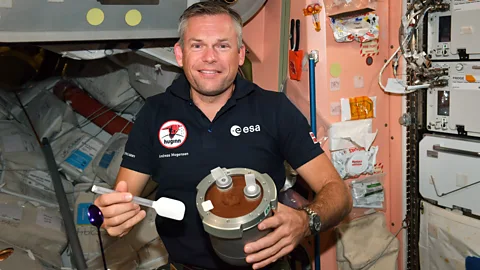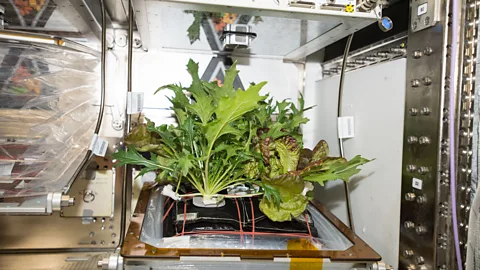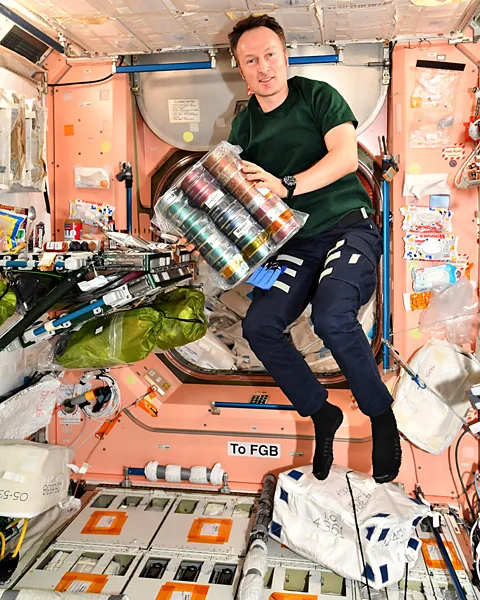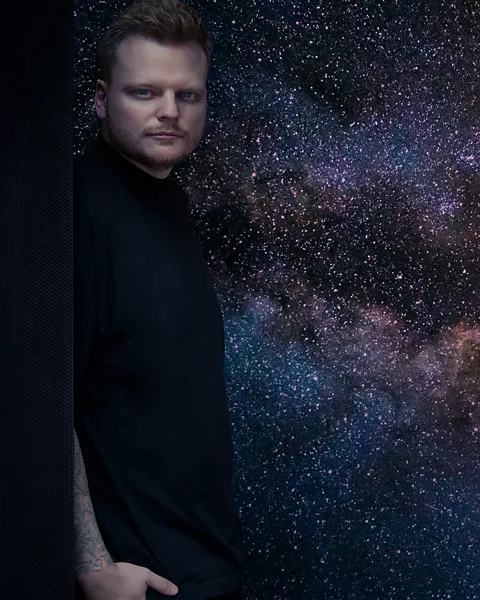What will we eat on the Moon? The food is literally out of this world
 Getty Images
Getty ImagesThe Moon may be the final frontier for mankind, but what will we eat when we get there? Pasta and protein bars made out of thin air are just the beginning.
Space fever is approaching at warp speed. In the next two years, Nasa plans to send astronauts back to the Moon via its Artemis programme; the International Space Station (ISS), designed to orbit for 15 years but now hitting its 26th year in space, will soon be replaced; and scientists are looking seriously into the possibility of manned deep space missions. Add to that a proliferation of tourism projects rocketing deep-pocketed individuals up to the edge of space and it begs one question for a food writer like me: what will we eat when we get there?
"Food is something that keeps astronauts sane," says Dr Sonja Brungs, astronaut operations deputy lead at the European Space Agency. "Good food, proper food with a lot of variety, tailored to the needs of the individual astronauts is crucial for a successful deep space mission. I think people underestimate how important it is."
Currently, astronauts are given small food pouches containing prepared meals. These meals are made by specialised food-production companies and then freeze-dried, dehydrated or thermostabilised. Astronauts add water to heat or cool the meals to eat; they can also bring along a special meal that reminds them of home (this too has to be carefully formulated and thermostablised).
There are some no-gos: anything that crumbs, like bread, can't be taken into space as the crumbs can easily become airborne in the low-gravity environment, meaning they could be inhaled or get into vital equipment. Salt is limited, due to the fact that the body stores sodium differently in space, leading to accelerated osteoporosis, and alcohol is also not permitted as it affects the waste water recycling system in the ISS.
 ESA/Nasa
ESA/Nasa"Novelty is definitely an issue," says Brungs. "Astronauts who are in space for just six months miss crunchiness and texture. It is really important for mental wellbeing to have a variety of textures, and especially for deep space missions, having a variety of foods to eat."
In 2021, Nasa launched a Deep Space Food Challenge to discover new ways to create food in space with limited resources producing minimal waste, while also providing safe, nutritious and tasty food that can perform on a long-term deep space mission.
Solar Foods, based in Helsinki, is one of the eight companies that has reached the challenge's final phase. Their remarkable concept: using space waste to create protein.
"We make food out of thin air, quite literally," says Artuu Luukanen, Solar Foods' senior vice president in Space and Defence. His company discovered an edible microbe in the Finnish countryside that grows by feeding on a mixture of carbon dioxide, hydrogen and oxygen. The result is a source of protein from bacteria. The protein can be blended with a range of flavours or textures to create various kinds of nutritious food, such as pasta, protein bars, alternative meats and even an egg replacement
"We started thinking about space food because in any space habitat, you have two key waste gases available: hydrogen and carbon dioxide," Luukanen said. "So what we are talking about here is really not just a food manufacturing technology for space, but something that will be an integral part of the environmental control and life support system."
 Nasa/Amanda Griffin
Nasa/Amanda GriffinSolar Foods' protein can be turned into a paste or powder and blended with flour and more typical food ingredients to create protein enriched foods such as pasta, protein bars and even chocolate. Experiments are continuing to discover whether it can be mixed with oils and turned into something with a texture of a steak, using a 3D printer.
Fresh food is also a consideration: while vitamin tablets can help, astronauts need fresh produce, and experiments continue into how to grow vegetables in this unique zero-gravity, zero-sunlight environment. The ISS has its own tiny vegetable garden on board, known as Veggie, where astronauts study plant growth in microgravity.
Back on Earth, Interstellar Lab on Merritt Island, Florida, has developed a modular bioregenerative system for producing microgreens, vegetables, mushrooms and even insects; the company is also a finalist in the Nasa Deep Space Food Challenge, along with Enigma of the Cosmos in Melbourne, Australia, a firm working on a way to grow microgreens efficiently in space.
One thing that seems likely is that the future of space food will include fungi. Three of the six finalists in the Nasa Deep Space Food Challenge are working on ideas around fungi, including Mycorena of Gothenburg, Sweden, which has developed a system that uses a combination of microalgae and fungi to produce a mycoprotein (a type of protein that comes from a fungus, often used in alternative meat products).
 ESA/Nasa
ESA/Nasa"Fungi is very versatile," explains Carlos Otero, who works in the R&D team at Mycorena. "It can grow on different substrates, it grows fast and you can design a small and efficient system capable of producing enough food for the crew. It is also very robust, resistant to radiation and easy to store and transport."
More like this:
This space food is all in a closed loop circular system, with an end product that can be 3D printed to create a food a little like the texture of a chicken fillet. An added benefit is that their protein source contains all the essential amino acids the human body needs to function.
As opportunities grow for private companies to enter the space race, so too do opportunities for private chefs. Chef Rasmus Munk of Michelin-starred restaurant Alchemist in Copenhagen is among many set for take off. Munk recently announced a partnership with SpaceVIP to cater an immersive dining experience on the private Space Perspective's Spaceship Neptune, where tickets cost £397,000 ($495,000) per person for a six-hour trip to the edge of space.
He's one of many chefs seeing the potential in catering for deep-pocketed tourists on commercial space flights. But while it's easy to see these developments as only for the very, very few who can afford such a trip (or make it as an astronaut), the development of space food is not just about what we'll eat in zero gravity, but what we may end up eating on our own planet. The Nasa Deep Space Food Challenge was also designed to create advanced food systems that will benefit us on Earth, enabling new avenues for food production in extreme environments and resource-scarce areas.
 Claes Bech Poulsen
Claes Bech Poulsen"We are facing big challenges when it comes to climate change, particularly regarding droughts that influence our food production capabilities," says Luukanen. "Space puts this into an ultimate test, where we utilise the resources that are considered waste from other activities and turn that into a value-added product. It's a philosophy of circular economy. Earth is the best spaceship that we've ever been on board, and it has limited resources."
For Kristina Karlsson, head of R&D at Mycorena, the same principle applies: "Our project is working towards resource efficiency on Earth as well as space," she says. "There are almost no emissions, and almost no waste. Space is just an extreme environment where you can challenge the development of this kind of project: if it works there, it's going to work on Earth."
The third phase of Nasa's Deep Space Food Challenge is underway this summer and aims to further test how these projects could work in space-like conditions. It's something to watch closely: while it's near certain that these novel foods will form part of an astronaut's nutritional profile in space, it also looks likely they will influence how we eat on Earth in the future too.
BBC.com's World's Table "smashes the kitchen ceiling" by changing the way the world thinks about food, through the past, present and future.
---
If you liked this story, sign up for The Essential List newsletter – a handpicked selection of features, videos and can't-miss news delivered to your inbox every Friday.
